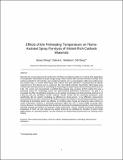Effects of the preheating temperature on flame-assisted spray pyrolysis of nickel-rich cathode materials
Author(s)
Zhang, Jianan; Muldoon, Valerie L; Deng, Sili
DownloadAccepted version (872.3Kb)
Open Access Policy
Open Access Policy
Creative Commons Attribution-Noncommercial-Share Alike
Terms of use
Metadata
Show full item recordAbstract
Reducing the cost and improving the performance of lithium-ion batteries (LIBs) are crucial for their applications in transportation electrification and grid energy storage. Much research effort has been devoted to develop novel synthesis methods for LIB cathodes, since traditional methods such as coprecipitation suffer long synthesis time and complex steps. In contrast, flame-based spray methods have great potential in manufacturing LIB cathode materials due to their features such as continuous, fast, and scalable operation. Nevertheless, flame-based spray methods also need improvement in controlling the morphology and improving the electrochemical performance of LIBs. The current work demonstrated a modified flame-assisted spray pyrolysis (FASP) method that used a preheating section for morphology control and electrochemical performance enhancement. The goal is to investigate the effect of preheating temperature on the particle morphology and electrochemical performance of Li(Ni0.8Co0.1Mn0.1)O2 (NCM811) cathode materials. Results showed that the preheating temperature could significantly alter the particle morphology by affecting the drying process. X-ray diffraction measurements demonstrated that the cation mixing level of NCM811 samples was sensitive to the preheating temperature, where introducing the preheating section was effective in inhibiting cation mixing and improving cation ordering at certain temperatures. However, a preheating temperature higher than 325 °C would notably encourage cation mixing. Moreover, the electrochemical tests showed that increasing the preheating temperature could improve the discharge capacity and stabilize the long-time cycling performance. Overall, carefully choosing the preheating temperature of FASP not only improved the particle uniformity by inhibiting the formation of hard-to-break agglomerations in calcinated powders, but also enhanced the electrochemical performance by hindering cation mixing.
Date issued
2023Department
Massachusetts Institute of Technology. Department of Mechanical EngineeringJournal
Proceedings of the Combustion Institute
Publisher
Elsevier BV
Citation
Zhang, Jianan, Muldoon, Valerie L and Deng, Sili. 2023. "Effects of the preheating temperature on flame-assisted spray pyrolysis of nickel-rich cathode materials." Proceedings of the Combustion Institute, 39 (1).
Version: Author's final manuscript